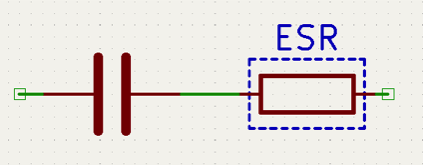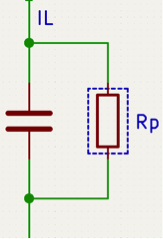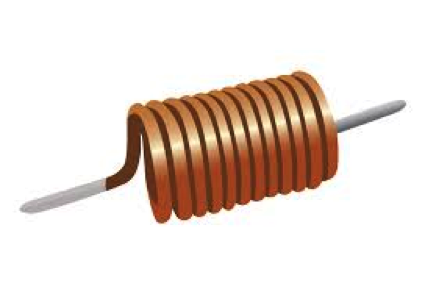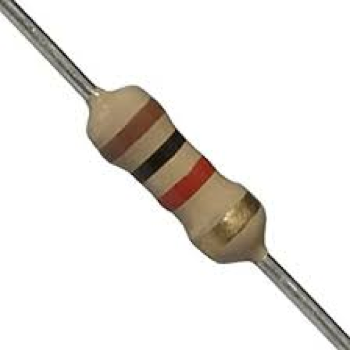Component selection is one of the most essential and critical processes when designing any electronic system. Improper component selection can lead to many problems in design, PCB layout, power budget, etc. In this article, we will discuss how to select a component for a low power optimized design.
Resistor
The power dissipated by a resistor is in the form of heat. When current flows through it, the resistor heats up. The main selection properties of a resistor are resistance, rated power, composition, temperature coefficient, operating temperature, thermal resistance, etc. For our purposes here, we will discuss the properties that cause power dissipation in resistors.

Figure 1: Resistor
Power Rating: Power rating is the maximum power that can be dissipated from the resistor without destroying the device. The conversion rate is the dissipation power. For example, if a resistor has a power rating of ¼ Watts, then ¼ Watts is the maximum amount of power that should be fed into the resistor.
Let's look at another example. Here, we have an 800Ω resistor with a voltage of 12 volts feeding the circuit to light an LED. The power that the circuit would be supplying is:
P=V 2 /R
Where V is the voltage across the resistor and R is its resistance.
P = 12*12/800 = 0.18W
Therefore, we must always ensure that the rated power of the resistor meets the circuit requirements.
Thermal Resistance (Rθ): The proportionality factor between energy dissipation and excess temperature and is generally expressed as
Rθ = dT/P
where Rθ is the thermal resistance, dT is the temperature change and P is the power dissipated. A lower value of Rθ indicates that thermal energy will be transferred more freely and will offer better energy performance. Therefore, the value of Rθ should be low when selecting a resistor.
Composition: There are different compositions of resistors, but lead (4.55×10 6 S/m) has lower thermal conductivity than copper (5.96×10 7 S/m) and does not dissipate heat like copper. Therefore, we should choose the resistor with the conductive wire composition. Lead resistors are more expensive than copper resistors, which limits their use.
Other ways to minimize power dissipation in the context of a resistor are as follows:
- When designing a PCB, heavy copper traces or ground planes (which act as heat sinks) reduce the temperature rise of wires and solder joints. Therefore, we must provide good ground planes and heavy copper traces to minimize heat dissipation.
Let's look at an example of a voltage divider that provides a 9V output from 12V:

Fig: 2 Voltage Divider Circuit
The equation for finding the output voltage of a divider circuit:
Vout = (R2/R1 + R2) * Vin
Where Vout is the output voltage, Vin is the input voltage and R1 and R2 are the resistance of resistors R1 and R2.
Vin = 12V, R1= 1K, R2= 3K
Vout = (3K /( 1K + 3K)) * 12V
Output = 9V
Now the current through the circuit will be:
I = Vin / (R1+ R2)
I = 12 /( 1K + 3K) = 3mA
P = IV = 3mA*12V=36mW
If we take the values of R1= 10K and R2= 30K then:
Vout = (30K / (10K + 30K))* 12V = 9V
I = 12 / (10K + 30K) = 0.3mA
P = IV = 0.3mA*12V=3.6mW
By increasing the resistor value in voltage divider circuits, LED driver circuits can reduce power consumption.
Capacitor

Figure: 3 Capacitor
The power dissipated by a capacitor results from its ESR, leakage current, etc. The main properties of a capacitor are capacitance, ESR, tolerance, rated voltage, temperature coefficient, operating temperature and leakage current. Several parameters are important to keep in mind when selecting a capacitor.
- ESR (Equivalent Series Resistance): The ESR (also known as internal resistance of the capacitor) of the capacitor is responsible for the energy dissipated in the form of heat and is directly proportional to the DF (Dissipation Factor).

Fig: 4 ESR Model
ESR = XC * DF
XC = 1/ (2 * PI * f * C)
where XC is the capacitive reactance, DF is the dissipation factor, C is the capacitance and f is the frequency.
ESR is frequency dependent, which makes it a “DYNAMIC” quantity. ESR is caused by many factors, such as ohmic losses in the cables and the plates themselves, as well as losses in the dielectric material used between the capacitor plates.
A high ESR value degrades performance as the capacitor will have less ability to pass current to and from its plates to the external circuit due to the longer charge and discharge RC time constant. The ESR of a capacitor needs to be as low as possible for all electronic circuit designs so that the capacitor's operation is as close to ideal as possible.
- Capacitor Leakage Current: The dielectric used inside the capacitor to separate the conducting plates is not a perfect insulator. When constant supply voltage is applied to a capacitor, the powerful electric fields generated by the charge on the plates result in minimal current leakage through the dielectric. The amount of leakage current varies depending on the size of the capacitor. Typically, electrolytic and tantalum caps have high leakage current, and ceramic and film capacitors have low leakage current.

Fig: 5 Leak Model
When selecting capacitors for a low-power embedded system, it is best to choose capacitors with low leakage current.
- Nominal Voltage: Nominal voltage is another important characteristic that defines the maximum continuous voltage, whether DC or AC, that can be applied to the capacitor without failure during its lifetime. Any voltage above its working voltage can cause failure, which is determined by the failure rate. A capacitor will have a longer lifespan if it is operated in a cold environment and within its rated voltage. Always use a capacitor with a rated voltage equal to or greater than the voltage applied to the circuit.
Inductor

Figure: 6 Inductor
Power dissipation in an inductor occurs in the windings and core, called winding loss and core loss. The significant properties of an inductor are material core, inductance, tolerance, current rating, shielding, DC resistance, Q, self-resonant frequency, operating temperature and inductance frequency. Following are important parameters that you should keep in mind while selecting an inductor.
- Q Factor, or Quality Factor: Refers to the relationship between the reactance of the coil and its resistance. This value depends on the frequency (Q=2πf L/R). Since f is the frequency of the current flowing through the coil, the value of Q will differ depending on the frequency. Higher Q value will cause lower losses and better suitability for use as a high frequency inductor.
- Self-Resonant Frequency (SRF): Describes the frequency at which an inductor stops functioning as an inductor. The self-resonant frequency can be expressed as:
SRF = 1/2 * PI * √LC
where L is the inductance and C is the parasitic capacitance.
This value must be higher than the application frequency. It would be better to consider that the self-resonant frequency should be sufficiently higher than the usage frequency.
- Saturation current: Refers to DC current, which causes the inductance to drop by a specified value. Furthermore, when an inductor can no longer store energy and instead experiences a drop in energy storage and inductance, it has reached the saturation point. The inductance drops because the core can only store a certain amount of magnetic flux density. The core material and wire insulation may be damaged at high temperatures if the current is high enough during operation. In most cases, the operation of an inductor is limited by temperature rise.
- DC Resistance (DCR): During the flow of DC power (frequency 0 Hertz), inductors provide resistance to current flow. This resistance is called DC resistance (DCR). DCR dissipates heat and reduces efficiency like any other resistor. In real inductors, the Q factor is reliable at DCR. The low DCR value is essential for lower power dissipation. It is best to use the inductor in certain ambient temperature conditions to operate them in the minimum DCR value region.
- Material Core: The core must be large enough and with low enough permeability to prevent saturation (or change in inductance below the minimum required level). This basic formula defines the power loss of an inductor:
Ploss = Pcore (Core loss) + Pdcr (Wire loss due to DC resistance) + Pacr (Wire loss due to AC resistance).
Here we will talk about the central loss.

Fig: 7 Hysteresis Curve
Hysteresis is a common property of ferromagnetic substances. The effect by which the magnetization of ferromagnetic materials lags behind the magnetic field is described as the hysteresis effect. The area of the hysteresis loop above in the figure represents the energy loss. The power loss depends on the number of times per second that the hysteresis loop is crossed. Thus, the hysteresis loss varies directly with frequency. Most commercial power supply inductors are gapped ferrites (Figure 7) , which are typically not low-loss materials and generally do not perform well in low-power, high-frequency applications. When designing inductors for low losses, use low permeability materials to decrease the B field (B magnetic field is a field produced by moving electrical charges), choose low loss core materials, and consider using Litz wire (multistrand wire) .

Fig: 8 Litz Wire
MOSFET

Figure: 9 Mosfet
Power dissipation in a MOSFET is mainly divided into two forms: resistive power dissipation and switching power dissipation. The internal resistance of the MOSFET causes resistive loss, and switching loss is the loss of power during turning MOSFETs on and off. Below are some of the important parameters that you should keep in mind while selecting a MOSFET:
- Maximum drain to source voltage (VDS): The drain-source voltage VDS rating is important in selecting MOSFETs. Choose MOSFETs with a VDS (drain-source voltage) sufficiently higher than the voltage at which they will be used, as a voltage higher than VDS can destroy a MOSFET. But with a high value of VDS, the RDS (resistance on state) results in loss of conduction. Both parameters must be observed when selecting the MOSFET.
- Drain Source On Resistance RDS (ON): RDS is the resistance value between the drain and source of a MOSFET during operation (ON). The RDS of MOSFETs is low when operating in the linear region. For switching applications, we can reduce the on-state resistance by using MOSFETs in the low VDS region, thereby reducing power loss. The amount of current that MOSFETs can handle is limited by the value of VGS. Furthermore, the higher the temperature, the higher the RDS(ON) value becomes, so it is important to also consider the temperature.
- Maximum DC Drain Current: This is the maximum current that a device can withstand indefinitely with adequate cooling. Depending on the VDS, the device may only carry a small fraction of this current before failure. The only way to be sure that the device can handle the desired current is to consult the safe operating area curve in the device datasheet.
- Considerations for VGS: MOSFETs turn on when VGS (gate-to-source voltage) exceeds their threshold voltage Vth. Choose a value for VGS that is greater than Vth. The higher the VGS, the lower the RDS(ON) value. Selecting the ideal gate voltage is therefore critical.
- Switching Speed: Switching losses are present at a higher frequency. To reduce these losses in high frequency and high speed power MOSFETs should be used. Compared to insulated-gate bipolar transistors (IGBT) and thyristors, power MOSFETs have very high switching speeds and better efficiency at low voltages.
DC/DC Converters
Different types of DC/DC converters include buck, boost, and flyback. Buck converters are used to reduce voltages while boost converters are used to increase voltages. The flyback converter is a buck-boost converter that can increase or decrease the voltage. Many factors must be considered to design DC/DC converters, such as power efficiency, transient response, input-output voltage ratio, efficiency, input-output isolation, input voltage range, maximum output current, line regulation /DC load and other factors. . Below are some of the parameters you should keep in mind while selecting a converter
- Input voltage range (VIN) parameter: The input voltage range is the maximum and minimum allowable input power of the converter. If the input power exceeds the maximum allowable input, the converter may be damaged.
- Maximum Output Current (IOUT) Parameter: This parameter is the maximum output current that the converter can provide while meeting the other parameters.
- Quiescent Current (IQ) Parameter: Quiescent current is the current used to operate the converter and is not delivered to the load. It is measured when the converter is enabled and the output/load current is zero. A low quiescent current maximizes converter output efficiency, reduces heat, and extends battery life in battery-operated applications. Choose low IQ current when selecting a DC/DC converter.
- Efficiency Parameter: Energy efficiency is defined as the percentage of input power delivered to output. It is expressed as:
Efficiency = 100 * (Iout * Vout) / (Iin * Vin)
An ideal switching converter can achieve 100% efficiency. Loss in converters includes switching loss and inductor loss. Power dissipation must be minimized to maximize efficiency.
- Switching Frequency: DC/DC converter circuits have their unique switching frequencies. A higher switching frequency enables the use of smaller inductors and capacitors and improves the step-load behavior of the converter. A higher switching frequency also increases switching losses by widening the frequency range of EMI radiation.

